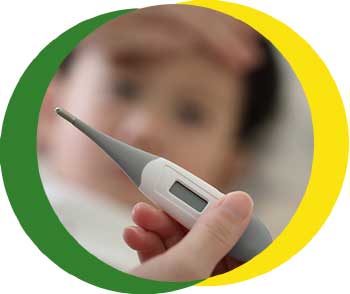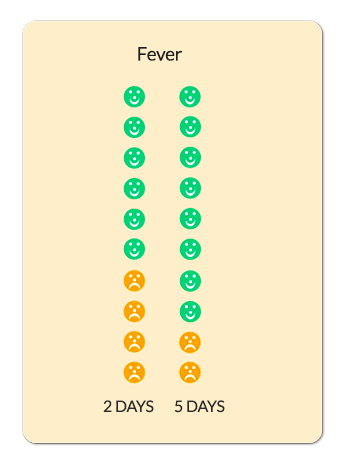Fever / high temperature

Fever is extremely common in children and usually suggests that your child has an infection. It’s really important that you measure your child’s temperature accurately – you should use a digital thermometer (under the the armpit (axillary) for children 5 years and younger, and in the mouth for children over 5 years of age). The other option is to use an in the ear thermometer (tympanic), although these should not be used in babies below 6 months of age.
- Viral infections are far more common than bacterial infections
- Symptoms such as runny nose, cough, wheeze, sore throat, red eyes and diarrhoea are more suggestive of a viral infection than a bacterial infection. If a number of people are unwell in the same household, this also suggests a viral infection (because viral infections are easily spread)
- Fever is common in babies up to 48 hours after receiving immunisations – it is okay to give paracetamol as per the instructions on the packaging after the MenB vaccine without seeking medical advice if your baby is otherwise well
- Occasionally, children with fever can have a seizure/fit. This is called a febrile convulsion and most commonly occurs in children aged between 6 months and 3 years. They generally occur on day 1 of the fever, and in most cases have no long term effects
- Viral infections tend to get better on their own and do not need treatment with antibiotics. Antibiotics may actually cause side effects such as rash and diarrhoea and can increase the risk of them developing antibiotic resistance
Operation Ouch – Fever
When should you worry?
If your child has any of the following:
- Becomes pale, mottled and feels abnormally cold to touch
- Is going blue around the lips
- Severe breathing difficulty – too breathless to talk or eat/drink
- Has a fit/ seizure
- Becomes extremely agitated (crying inconsolably despite distraction), confused or very lethargic (difficult to wake)
- Develops a rash that does not disappear with pressure (the ‘Glass Test’)
- Is under 3 months of age with a temperature of 38°C / 100.4°F or above (unless fever in the 48 hours following vaccinations and no other red or amber features)
You need urgent help
Go to the nearest Hospital Emergency (A&E) Department or phone 999
If your child has any of the following:
- Is finding it hard to breath
- Seems dehydrated (sunken eyes, drowsy or not passed urine for 12 hours)
- Is becoming drowsy (excessively sleepy) or irritable (unable to settle them with toys, TV, food or picking up) – especially if they remain drowsy or irritable despite their fever coming down
- Has extreme shivering or complains of muscle pain
- Is 3-6 months of age with a temperature of 39°C / 102.2°F or above (but fever is common in babies up to 2 days after they receive vaccinations)
- Continues to have a fever of 38.0°C / 100.4°F or more for more than 5 days
- Is getting worse or if you are worried
You need to contact a doctor or nurse today
Please ring your GP surgery or call NHS 111 – dial 111
We recognise that during the current COVID-19 crisis, at peak times, access to a health care professional may be delayed. If symptoms persist for 4 hours or more and you have not been able to speak to either a member of staff from your GP practice or to NHS 111 staff, then consider taking them to your nearest Emergency Department
If none of the above features are present
Additional advice is also available to young families for coping with crying of well babies.
Self care
Continue providing your child’s care at home. If you are still concerned about your child, call NHS 111 – dial 111
What should you do?
- To make your child more comfortable, you may want to lower their temperature using paracetamol (Calpol) and/or ibuprofen as per the instructions on the packaging. If you’ve given your child ibuprofen and if they’re still uncomfortable 2 hours later, you could try giving them paracetamol as well. If this works, you can alternate paracetamol and ibuprofen (every 2-3 hours), giving only 1 medicine at a time. Do not give more than the maximum daily dose of either medicine and find out more information on medicines
- However, remember that fever is a normal response that may help the body to fight infection and paracetamol/ibuprofen will not get rid of it entirely. Paracetamol and Ibuprofen bring down the temperature but do not treat the infection so whilst the child is unwell they will continue to get temperatures once the effects of the medication have worn off
- Avoid sponging your child – it doesn’t actually reduce your child’s temperature and may cause your child to shiver
- Encourage them to drink plenty of fluids
- If a rash appears, do the glass test
How long will your child’s symptoms last?
- Fever caused by a viral infection tends to improve within 2 to 3 days
- If your child’s fever lasts for more than 5 days, get them seen by your GP
- The chart below shows how long fever lasts in a child with viral infections. The faces represent 10 children who have seen their GP with a viral infection. Green faces are those children whose fever has recovered within that time period

Where should you seek help?
- If it is non-urgent, speak to your local pharmacist or health visitor.
- If your child has any of the above features, urgently see your GP. For an urgent out-of-hours GP appointment, call NHS 111.
- You should only call 999 or go your nearest A&E department in critical or life threatening situations.

